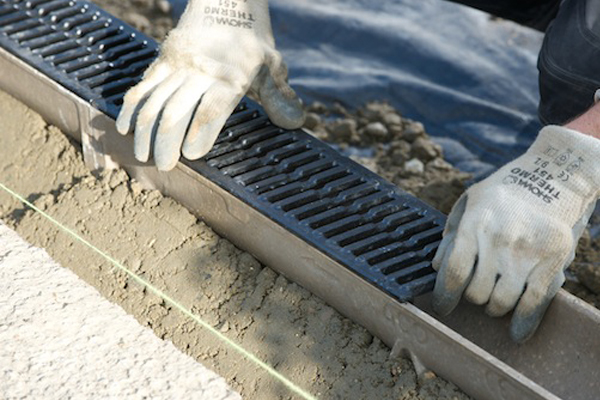A Class Apart: Drainage Load Classes
A class apart: all you need to know when it comes to drainage.
Drainage channels are a staple product on many new-build developments and extension projects up and down the country. However, viewing them with a ‘one size fits all’ mentality can easily result in the wrong product being installed. Getting to grips with how they’re classified can make a big difference in ensuring installers fit what’s most suitable for the job in hand.
Here, Oliver Collins, Product Marketing Manager – Building + Landscape at ACO Water Management, delves deeper into drainage channel load classes and explains why you need to know your A 15’s from your B 125’s.

Given the country’s tendency to suffer from wet weather all year round, and the subsequent need to shift surface water in a variety of domestic applications – from roads and car parks to driveways and patios – drainage channels are an incredibly common building product. Often bought by the metre, and generally purchased or specified on price, drainage channels can easily slip into a ‘fit and forget’ category. However, by not taking the time to fully consider the final application, installers can quickly find themselves confronted by disgruntled buyers demanding for the work to be re-done if a product with the wrong load class was installed.
Low Down on Load Classes
In accordance with BS EN 1433:2002, all drainage channels are classified into load classes, which are effectively different categories detailing the load-bearing capacity of that product. Ranging from A 15 for pedestrian footpaths and patios, through to F 900 for airports and industrial yards, the system is a quick way of ensuring that, if you are fitting out a driveway or a patio, the right channel and grating – i.e. one that will stand up to the rigours of the application – is selected.
However, while the load class system itself is a fairly simple specification tool to follow, it’s one that surprisingly few people are fully up to speed with.
A Case in Point
Let’s put the issue into context. A 15 is the most commonly used drainage channel, and a staple commodity that installers often buy from their merchant again and again due to its familiarity, availability, and cost.
While an A 15 channel, such as ACO’s classic HexDrain channel or HexDrain Brickslot channel, would be fine for paths or patios with no vehicular traffic located around a property, they should not be installed at the entrance or in the middle of a driveway.
This is because the product does not have the load-bearing capacity to withstand the pressure of a car or delivery van turning or parking on it, and could fail. For driveways, a channel with a B 125 load class – such as ACO’s RainDrain B 125 channel – would be the minimum option we’d recommend, as it is the next load class up, has a higher load-bearing capacity.

Weakest Link
While A 15 and B 125 may be the most commonly bought drainage channels, the same principle applies to all load classes and applications. For instance, if the installer was also responsible for building any flats as part of the development then B 125 would be sufficient for a small car park mainly used by domestic vehicles. However, if it were a large car park open to the public, such as one supporting municipal facilities within a housing estate such as a row of shops or a library, where vans or commercial vehicles could feasibly park, then either a C 250, such as the ACO HexDrain Pro channel, or a D 400 solution is likely to be the best option.
Below is a useful reference chart for common applications that require drainage channels, and what load class is required:
|
Application |
Load Class |
ACO Product |
|
Pedestrian, cycleways, low traffic areas (light domestic vehicles only). |
A 15 |
HexDrain, HexDrain Brickslot, RainDrain, Threshold Drain & Doorway Drain |
|
Pedestrian precincts, light vehicles, private car parks and driveways. |
B 125 |
HexDrain B 125, RainDrain B 125, RainDrain Brickslot B 125, Eyeleds & Doorway Drain B 125 |
|
Parking areas, service stations (cars) and slow-moving light commercial vehicles. |
C 250 |
HexDrain Pro & Civic Drain |
|
Public Highways, parking areas for all types of vehicles. |
D 400 |
Multiline Sealin, MultiDrain MD, MultiDrain PPD, Light Point, MonoDrain, KerbDrain, S-Range & Qmaxx |
|
Industrial areas, heavy wheel loads, slow-moving HGV’s and forklifts, service stations. |
E 600 |
RoadDrain, H-Range, S-Range & Qmaxx |
|
Airport runways, very heavy industrial and military installations, service yards and lorry parks. |
F 900 |
RoadDrain, H-Range, S-Range & Qmaxx |
Final thoughts
In short, whilst drainage channels might seem like a commodity product, there’s much more to them than that. By cross-referencing the intended end-use with the load class and limitations of each product, installers can ensure the right drainage solution for the application in question is used. It might not seem like a big thing, but it will go a long way to keeping your buyers happy, and ensuring a job only ever needs to be done once.
For more information on ACO Technologies’ range of drainage solutions, please visit www.aco.co.uk.
Guest Post by ACO
Recent Posts
-
An Introduction to Types of Paving
There are so many different types of paving out there, but which ones are right for your project? Wh
-
10 small outdoor kitchen ideas just in time for summer
As summer approaches, many homeowners are looking for ways to enhance their outdoor living spaces&md

